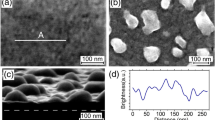Abstract
Stresses formed in oxide scales due to oxide growth are usually of a compressive nature, and there is still some debate on how these stresses are accommodated. While the deformation behavior of oxide scales under tensile stresses can be regarded as fairly well understood, there are many open questions concerning scale deformation and cracking under compressive straining. Therefore, the NiO scale formed on two different grades of Ni was chosen as a model system for compression tests with strain rates ranging from 8×10−4 to 8×10−8 s−1 in the temperature range of 20 to 800°C. Test environments were air and argon, and accompanying acoustic-emission measurements were taken in order to detect the beginning of oxide-scale cracking during straining. As a result the critical-strain values at the beginning of mechanical-scale damage could be determined quantitatively and explained consistently by model considerations. Furthermore, SEM and TEM investigations, backed up by sulfur decoration of microcracks at the end of the tests, revealed that at elevated temperatures a major deformation mechanism under these conditions takes the form of dynamic equilibrium of continuous microcracking with superimposed oxide-healing processes, making compressive strains of 10% and more possible without macroscopic scale failure. It is, therefore, assumed that a major mechanism of growth stress relief in oxide scales occurs via microcracking and scalecrack healing.
Similar content being viewed by others
References
H. W. Grünling, B. Ilschner, S. Leistikow, A. Rahmel, and M. Schmidt inBehaviour of High Temperature Alloys in Aggressive Environments, I. Kirman et al., eds. (The Metals Society, London, 1980), p. 869.
N. B. Pilling and R. E. Bedworth,J. Inst. Met. 29, 529 (1923).
H. L. Bernstein,Met. Trans. A 18, 975 (1987).
F. N. Rhines and J. S. Wolf,Met. Trans. 1, 1701 (1970).
Zhou Peide, F. H. Stott, R. P. M. Procter, and W. A. Grant,Oxid. Met. 16, 409 (1981).
A. Atkinson, R. I. Taylor, and P. D. Goode,Oxid. Met. 13, 519 (1979).
A. Atkinson and D. W. Smart, Harwell Report AERE R 12762, United Kingdon Energy Authority, Harwell, 1987.
A. Brinkmann, R. Emmerich, and S. Mrowec,Oxid. Met. 5, 137 (1972).
D. G. Barnes, J. M. Calvert, K. A. May, and D. G. Lees,Phil. Mag. 28, 1303 (1973).
D. Caplan and G. I. Sproule,Oxid. Met. 9, 459 (1975).
G. M. Ecer and G. H. Meier,Oxid. Met. 13, 119 (1979).
K. P. Lillerud and P. Kofstad,J. Electrochem. Soc. 127, 2397 (1980).
P. Kofstad and K. P. Lillerud,J. Electrochem. Soc. 127, 2410 (1980).
F. A. Golightly, F. H. Stott, and G. C. Wood,Oxid. Met. 10, 163 (1976).
F. A. Golightly, G. C. Wood, and F. H. Stott,Oxid. Met. 14, 217 (1978).
R. G. Miner and V. Nagarajan,Oxid. Met. 16, 313 (1981).
M. Schütze and A. Rahmel, inHigh Temperature Corrosion, R. A. Rapp, ed. (NACE, Houston, 1983) p. 421.
M. I. Manning,Corros. Sci. 21, 301 (1981).
M. Schütze,Die Korrosionsschutzwirkung oxidischer Deckschichten unter thermischchemisch-mechanischer Werkstoffbeanspruching, (Gebr. Borntraeger Verlag, Berlin, 1992).
M. Schütze,Oxid. Met. 24, 199 (1985).
J. Barbehön, VDI-Fortschrittsbericht Nr. 138 Reihe 5, VDI-Verlag, Düsseldorf, 1988.
P. Hancock and J. P. Nicholls,Mater. Sci. Technol. 4, 398 (1988).
M. Walter, A. Rahmel, and M. Schütze,Oxid. Met. 39, 389 (1993).
M. Walter, A. Rahmel, and M. Schütze,Oxid. Met. 40, 37 (1993).
M. Schütze,Mater. Sci. Technol. 6, 32 (1990).
M. Schütze,Oxid. Met. 25, 409 (1986).
W. Christl, A. Rahmel, and M. Schütze,Oxid. Met. 31, 35 (1989).
W. Christl, A. Rahmel, and M. Schütze,Oxid. Met. 31, 1 (1989).
M. Schütze, inHigh Temperature Corrosion of Advanced Materials and Protective Coatings, Y. Saito et al., eds. (North-Holland, Amsterdam, 1992), p. 39.
C. Liu, Thèse de Doctorat, ENSAM, Paris, 1991.
Manufacturer's Catalogue 1990/91, Goodfellow, Eschborn.
I. Küppenbender, Doctoral Thesis, Rheinisch-Westfälische Technische Hochschule, Aachen, 1993.
J. Robertson and M. I. Manning,Mater. Sci. Technol. 6, 81 (1990).
Author information
Authors and Affiliations
Rights and permissions
About this article
Cite this article
Küppenbender, I., Schütze, M. The deformation behavior of NiO scales on Ni in argon and air at temperatures from 20 to 800°C with respect to the relief of growth stresses. Oxid Met 42, 109–144 (1994). https://doi.org/10.1007/BF01061927
Received:
Issue Date:
DOI: https://doi.org/10.1007/BF01061927




